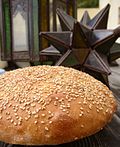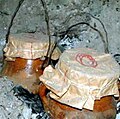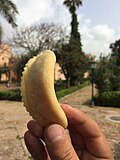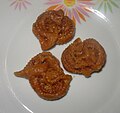Name
Other names | Image | Type | Description |
|---|
| Baghrir |  | Entrée | A yeasted semolina pancake. [1] |
| Briouat |  | Entrée | Triangular or cylinder-shaped savory or sweet pastry covered with warqa (a paper-thin Moroccan dough) [2] [3] |
| Boulfaf skewers |  | Entrée | Cubed lamb liver wrapped in lamb fat, grilled on skewers [1] |
Bourekas
Burek |  | Entrée | |
| Couscous |  | Main course | Semolina, meat, and vegetables. Traditionally 7 vegetables. [1] |
| Ferakh Maamer | | Entrée | A dish of spring chicken stuffed with sweetened couscous and enhanced with raisins, orange-flower water, almonds, and sugar. The ingredients are then placed in a large casserole and simmered slowly in a sauce made of honey, onion, garlic, ginger, cinnamon, and saffron. [4] [3] |
| Harira |  | Entrée | Thick soup based on tomatoes (beans, lentils and other products can be added) |
| Bissara |  | Entrée | A soup prepared with dried, puréed broad beans as a primary ingredient |
| Kefta magawara | | Main course | Kefta tajine served with tomato, eggs [1] |
| Kemia | | | An array of small dishes [3] |
Khlea
khli [1] or Kleehe [5] |  | Breakfast | Preserved dried meat [6] |
| Khobz |  | bread | Bread |
| Lentil soup |  | soup | Soup made with lentil |
| Merguez |  | | A spicy lamb sausage [1] |
| Ma'quda |  | | potato fritter |
| Méchoui |  | Main course | Roasted lamb |
| Milina | | Entrée | Chicken/Eggs |
| Moroccan cigars |  | Appetizer | Ground beef wrapped in dough |
| Mrouzia |  | Main course | A sweet dish of lamb with raisins, almonds and honey |
| Djaj mqalli | | Entrée | Chicken cooked with preserved lemon |
| Pastilla |  | Entrée | Chicken/Almonds/Seafood |
| Rfisa | | | A dish made with shredded pieces of pancake and chicken (djej beldi) |
| Rfissa |  | Main course | Lentils encased in filo pastry soaked in meat broth |
| Sardine |  | Entrée | Sardines with preserved lemon |
| Tajine |  | Main course | Meat, vegetables |
| Tangia |  | Main course | Meat, vegetables (a typical dish of Marrakesh) |








































